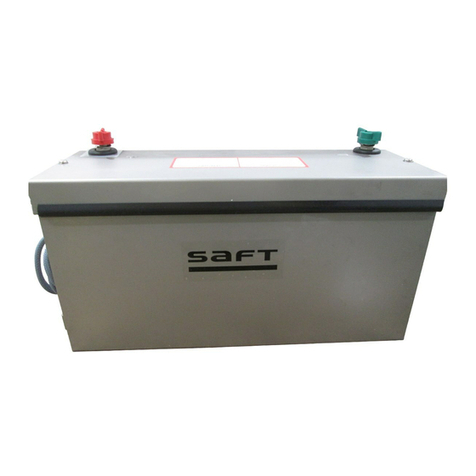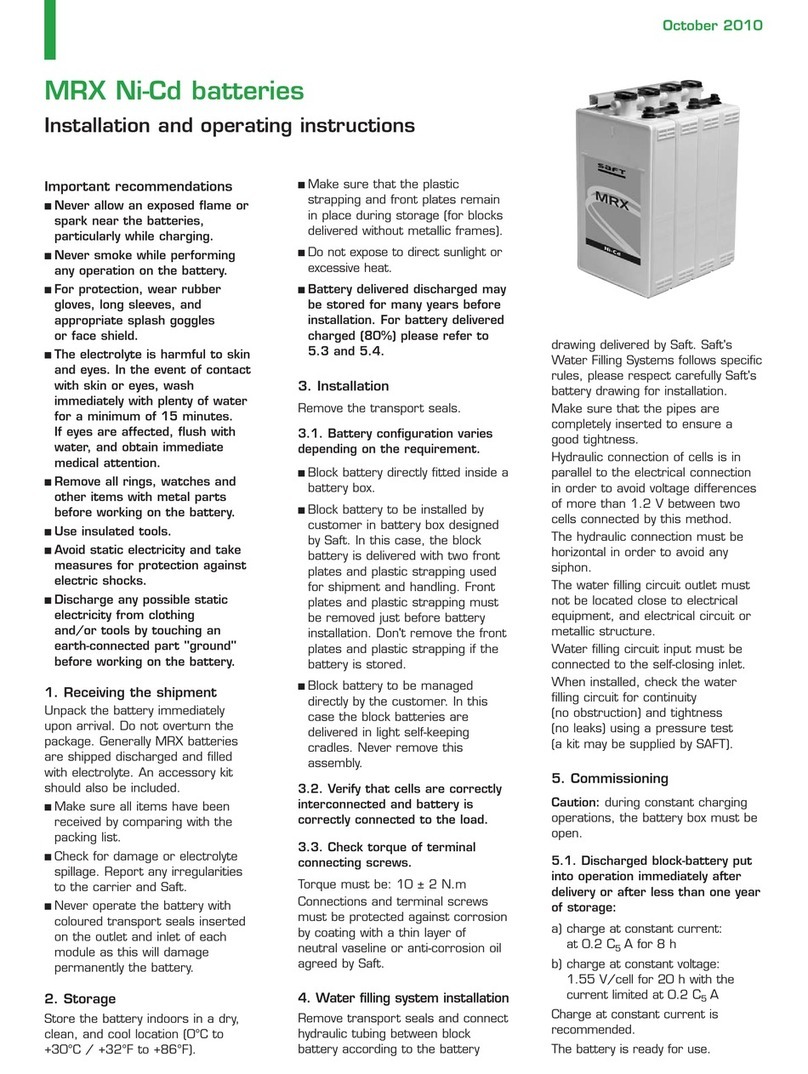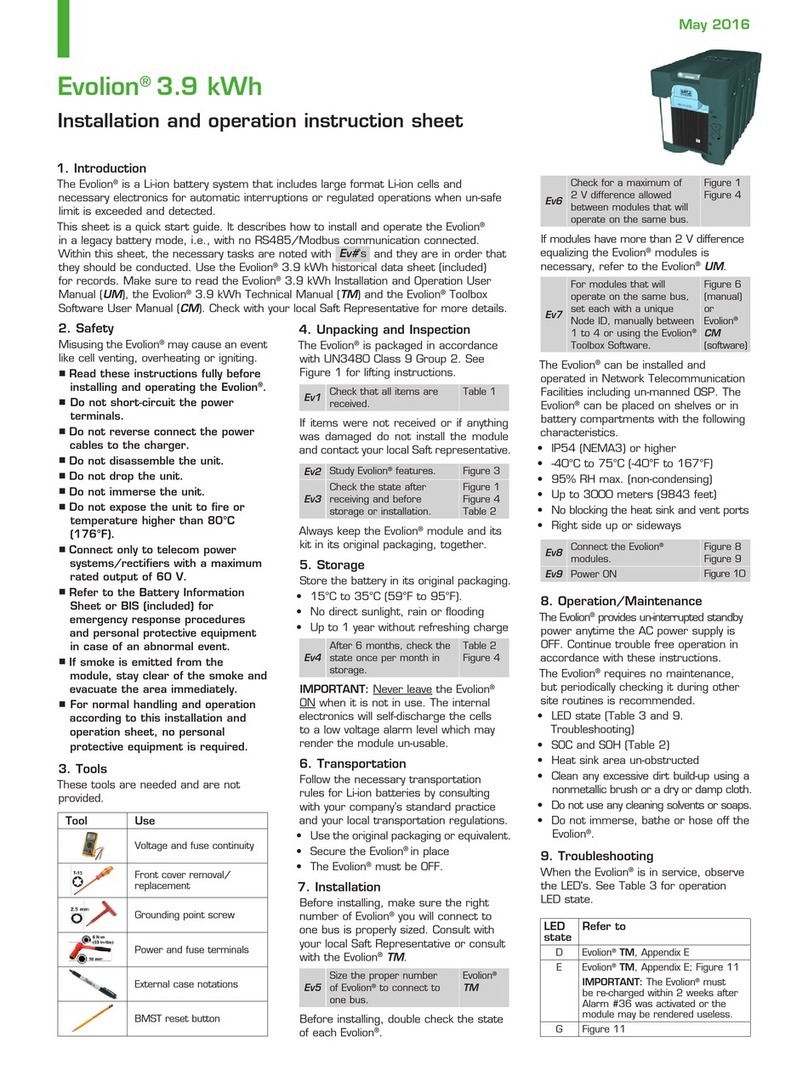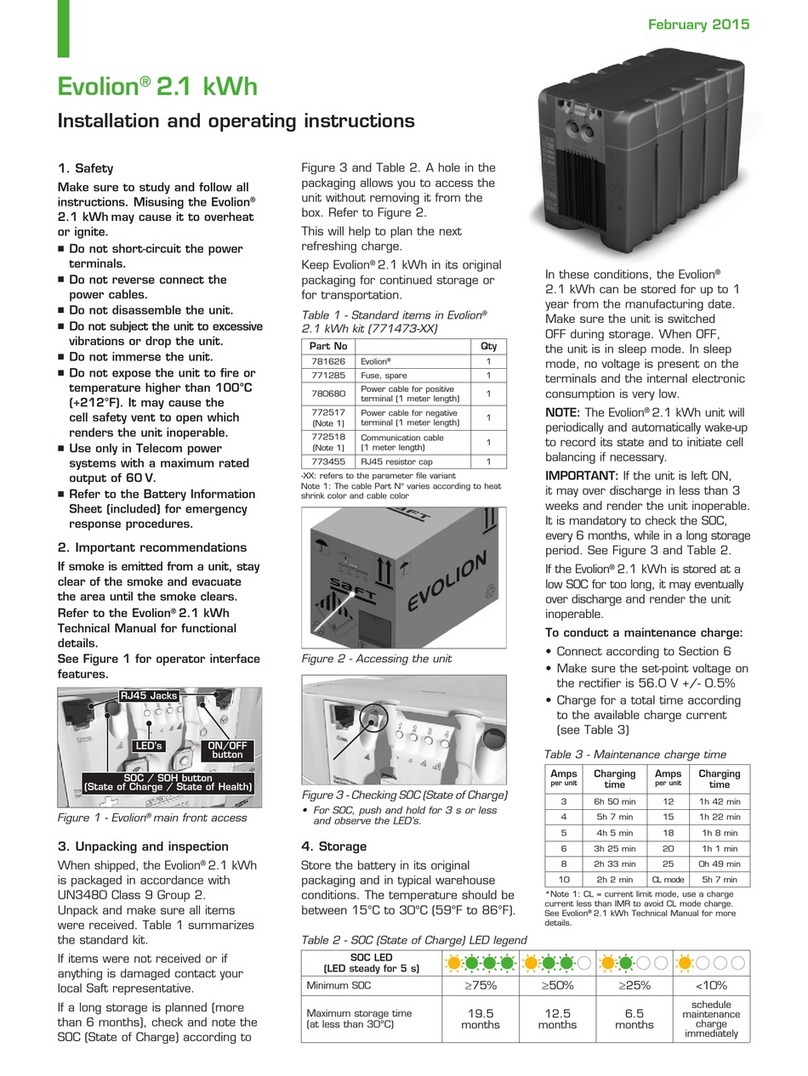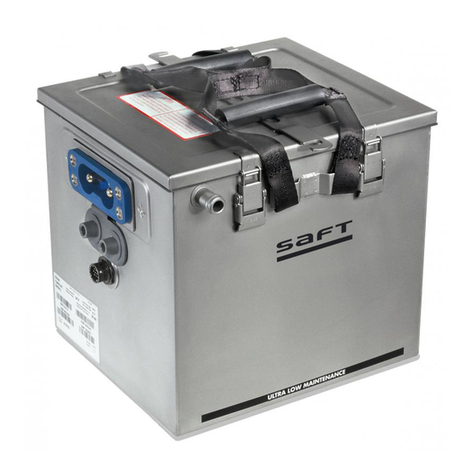Saft 2506 User manual

SAFT
2506
NICI(E1-
CADMIUM
BATTERY
OVERHAUL
MANUAL
WlTH
ILLUSTRATED
PARTS
LIST
24-31
-1
7
JUN
15/75
The document reference is online, please check the correspondence between the online documentation and the printed version.

The document reference is online, please check the correspondence between the online documentation and the printed version.

SAFT
OVERHAUL
MANUAL
2506
21-31-17
RECORD
OF
REVISIONS
Page
1
JUN
15/75
BY
ISSUE
DATE
REV
No
DATE
INSERTED
BY
.
REV
No
ISSUE
DATE
DATE
l
NSERTED
The document reference is online, please check the correspondence between the online documentation and the printed version.

The document reference is online, please check the correspondence between the online documentation and the printed version.

SAFT
OVERHAUL
MANUAL
2506
LIST
OF
EFFECTIVE
PAGES
Title page
Record
of
Revisions
List of
Effective
Pages
Table
of
Contents
List
of
Approved
Repair
Facilities
Foreword
DATE
OF
PAGE
LATEST
PAGE
REVlSlON
1
JUN
15/75
1
2
1
JUN
15/75
3
4
5
1
JUN
15/75
6
7
8
1
JUN
15/75
9
10
11
1
JUN
15/75 12
13
14
1
JUN
15/75 15
16
17
DATE
OF
LATEST
REVlSlON
JUN
15/75
JUN
15/75
JUN
15/75
JUN
15/75
JUN
15/75
JUN
15/75
JUN
15/75
JUN
15/75
JUN
15/75
JUN
15/75
JUN
15/75
JUN
15/75
JUN
15/75
JUN
15/75
JUN
15/75
JUN
15/75
JUN
7
5/75
JUN
15/75
TP
1001
Page
1
JUN
15/75
INTRO
1001
Page
1
JUN
15/75
lNTRO
1001
Page
2
JUN
15/75
INTRO
1001
Page
3
JUN
15/75
VCI
1001
Page
1
JUN
15/75
NI/ALPHA
1001
Page
1
JUN
15/75
NI/NUM
1001
Page
1
JUN
2
5/75
JUN
15/75
JUN
15/75
24-31
-1
7
LIST
OF
EFFECTIVE
PAGES
Page
1
JUN
15/75
The document reference is online, please check the correspondence between the online documentation and the printed version.

The document reference is online, please check the correspondence between the online documentation and the printed version.

SAFT
OVERHAUL MANUAL
2506
TABLE
OF
CONTENTS
DESCRIPTION
AND
OPERATION
2
TESTS
AND FAULTFINDING
DlSMANTLlNG
CLEANING
CHECKING
REPAl
RS
ASSEMBLY
AND
STORAGE
CLEARANCES
AND
TOLERANCES
TOOLS AND SPECIAL EQUIPMENT
1
LLUSTRATEDPARTS LIST
Page
1
3
7
7
8
14
15
N/A
16
1
O01
-1
24-31
-1
7
TABLE
OF
CONTENTS
Page
1
JUN
15/75
The document reference is online, please check the correspondence between the online documentation and the printed version.

The document reference is online, please check the correspondence between the online documentation and the printed version.

SAFT
OVERHAUL
MANUAL
24-31
-1
7
LIST OF APPROVED
REPAIR
FACILITIES
Page
1
JUN
15/75
COMPANY
SAFT
(SOC1
ET€
DES
ACCU-
MULATEURS
FIXES
ET
DE
TRACT1
ON)
SAFT United Kingdom Ltd
(Subsidiary
of
SAFT)
SAFT South Africa
(Pty)
Ltd
(Subsidiary
of
SAFT)
SAFT
Batterie Limited
(Subsidiary
of
SAFT)
SAFT
AMERICA
INC
(Subsidiary of
SAFT)
ADDRESS
156,
Avenue
de
Metz
93230
ROMAINVILLE
-
FRANCE
Castle Works Station Road
HAMPTON,
Middlesex
Phone
01
979
7756
-
Telex
23572
Private
bag
10
BRAMLEY
TRANSVA
Phone
406651
-
Telex
436461
143
Bermondsey Road TORONTO 16
(Ontario)
Phone
(41
6)
752-3030
-
Telex
0822997
71
1 Industrial Boulevard
VALDOSTA
-
Georgia 31601
Phone 912
247
2331
-
Telex 547620-l-
The document reference is online, please check the correspondence between the online documentation and the printed version.

The document reference is online, please check the correspondence between the online documentation and the printed version.

SAFT
OVERHAUL
MANUAL
2506
FOREWORD
This overhaul manual contains instructionsfor maintenancetogether with an illustrated
list
of
component parts for the type
2506
alkaline battery
These instructions, presented
in
accordance with specification
ATA
no.
100
of the manufacturer's
technical manual, are grouped inchapters inthe following order
:
-
descriptionand operation,
-
tests
and
faultfinding,
-
dismantling,
-
cleaning,
-
checking,
-
repairs,
-
assernbly and storage,
-
clearances and tolerances,
-
tools and special equipment,
-
illustratedparts list
NOTE
;
In
no
case may the instructions inthis manual
be
used
as
a
specification for acceptancetests;
they are for
OPERATION,
CHECKING of equipment temporarily out of service, and tocarry
out REPAl
RS
for overhaul
24-31
-1
7
FOREWORD
Page
1
JUN
15/75
The document reference is online, please check the correspondence between the online documentation and the printed version.

The document reference is online, please check the correspondence between the online documentation and the printed version.

SAFT
OVERHAUL MANUAL
2506
1
-
DESCRIPTION AND
OPERATION
(11
GENERAL
The
2506
battery comprises
20
semi-open, nickel-cadmium
VP
250
KH
cells with welded
polyamide cases
It
is connected to the on-board system of the aircraft for
:
-
starting of the engine or of the auxitiaiy power unit,
-
supply of on-board
d
c
services
:
-
on the ground before the on-board system
in
on normal supply,
-
airborne
in
case
of
fault
or
faiture
in
the
normal
suppiy
(2) CHARACTERISTICS
a)
TECHNICAL
Nominal voltage
:
24
volts
Rated capacity
:
23
Ah
at
1
hr rate
Connector
:
BAC type
102
Cannon KPTM-07-E-10-6-P(or equivalent)
(*)
Electrolyte
:
soln
KKOH
s
g 1
30
Consumable volume of electrotyte
:
21
cm3
Dimensions
mm
:
362
x
168
x
21
8
(inckes
:
14
26
x
6
62
X
8.59)
Weight
:
27
5
kg
k
2
%
(60
6
Ibs)
('1
Applicable
to
the
battery
fitted
with
the
thermaf
sensor
according
to the
FAA
Airworthinen
Directives
72-1
9-4
b)
APPLlCATION
Operation
:
Forced ventilation
Operatingtemperature
:
i-
50"
C
to
-
30"
C
lnternal resistance
:
O
010
ohm
Max
instantaneous power (at
+
25O
C)
:
17
kW
(1310
arnp
13 volts)
(3)
DETAILED
DESCRIPTION (seepages1001-Oand
1001-1)
The
battery of
20
VP
250
KH
cells
(7),
is
contained in
a
stainless steel box
Vertical retention
is
ensured
by
means
of
a piece moulded in silicone elastomer
(5),
cemented to the cover and carrying
a
number
of
bosses which press against the tops
of the cells
(7)
Connections between cells are
made
by
rigid nickel plated copper
strips
(28,
29,
30,
31
and 32), the end cells being connected by special rigid connections
(21
-22)
to an
electrical connector
(24)
BAC
102.
This connector
provides
the means of connection
ta
the aircraft
bus
The
box
(2)
is
fitted with
:
-
a removable cover
(3),
-
rwo
lifting handles,
-
two ventilation tubes
MONITORING
THE
TEMPERATURE
OF
THE
BATTERY
In order
to
comply with the
FAA
Airworthiness Directives (72-19-4)the type
2506
battery
can be fitted with
a
thermal sensor assembly
(33)
The thermostat, fixed
by
a
self-locking nut
(34),
on
a
special intercell connector
(32)
in the
middle of
the
battery, is connected by cables to a standard connector
The
cabies are retained by rneans of a grommet
(35)
When
the battery temperature reaches 71°
C
5
2
8
(160°F),
a
warning device situated on
the flight deck is operated
24-31
-1
7
Page
1
JUN
15/75
The document reference is online, please check the correspondence between the online documentation and the printed version.

SAFT
OVERHAUL
MANUAL
2506
B
-
OPERATION
(1)
CHARGE
a)
CHARGE
ON
AIRCRAFT
In
order that the battery shall
be
correctly charged inflight,
it
is essential that the
chargingsource should be correctlyadjusted, and that its operation should be checked
as frequently as possible
Inconditions of normal temperature
$20
OC
(t68
OF)
the constant charge voltage must
be
28
5
volts
If
the climatic or battery operating conditions cause thecell temperature to
rise to
4-40
OC
(4-
104
OF)
continuously,
it
is necessaryto readjust the setting of the
chargingsource to between 27
5
and
28
volts toavoid too rapid
a
ioss
of
electrolyte
reserve
For agiven voltage setting, a high battery temperature means a high residual charge
current
The consumptionof water from the electrolyte is indirect proportiontothis residual
charge current Itis thus absolulety necessary to know exactly the normal operating
temperature of the batteries
in
order tochargethem under optimumconditions
b)
GROUND
CHARGING
Whilst the battery
is
inuse onthe ground (forequipment testing, for example),
it
must
be recharged as necessary, usingavailable apparatus, by one of the following methods
:
WARNlNG
:
Groundchargingof
the
2506 battery must be carried out with the cover
removedtoavoid accumulation of gas inthe battery box
Constantcurrent charge
-
Battery completely discharged
-
single rateof charge
:
Charge
at
0,l
Cl
ampere until the battery voltage reaches an average of
1
5
volt x n
(30
volts for
20
cells), then continue at this same rate for
4
additional hours When
following this method, the total charge time must
be
at least
14
hoursbut no more
than
t
5
hours
-
Two
rates of charge
:
a)
rate one
:
O
5
Cl
ampere untilthe battery voltage reaches
1
55
volt
x
n
(31
volts
for
20
cells),
(minimumtirne
:
2
hours
;
maximum time
:
2
hours
30
minutes)
b)
rate two
:
O
1
Cl
amperefor
4
additional hours
a) rate one
:
C,
ampere untilthe battery voltage reaches
1
57
volt
x
n
(31
4
volts
for
20
cells),
(minimumtime
:
1
hour
;
maximum time
:
1
hour 15minutes)
b)
rate two
:
O
1
Cl
amperefor
4
additional
hours
Constant voltagecharge
Recharge may,
if
desirable,
be
given
using
a
constant
potential
source
comprising,
for
example, an aircraft generator with
its
voltage regulator
Innormal conditions of temperature
(+20
OC
or 68
OF),
the regulator must be set
,
between
28
and
28
5
volts (meter
O
5
%)
and the duration of charge
is
4
to
5
hours
24-31
.17
Page
2
JUN
15/75
The document reference is online, please check the correspondence between the online documentation and the printed version.

SAFT
OVERHAUL
MANUAL
2506
e
Rapid paltial clia~ge(batte1
y
completely dischaiged)
Charge at
O
5
C,
rirnpeics
until the battery voltage reachesan average
of
1
55
volt per cell
(31
volts for
a
20-cell battery),but for no longer than
2
hourç
1
5
minutes
Charge
a
C,
amperes until the battery voltage reaches an average of
1
57
volt per cell
(31,4
volts for a 2-cell battery),but for no longerthan
1
houi
15
minutes
Either
of
these two methodswill charge the battery toabout
80
%
of its capacity Inan
ernergency, the battery can be piaced inthe aircraft inthis condition where
it
will
be
fully
charged inflight
NOTE
:
This chargeshould not
be
used
during maintenanceof the battery
On
the ground with the enginestopped; inflight, inthe case of
a
fault inthe normal
d
c
power supply, the battery alone supplies the on-boardsystem
The ratedcapacity (23Ah) corresponds tothe one hour discharge rate
:
i
e
23
amp for one
hour
The
battery will alwayssupply without harm very much higher currents but
for
shorter
periods
A
part from regular current and periodical maintenance, the only precautionsnecessary
to
obtain good service fromthe battery are as follows
:
-
Do not install the battery inan aircraft location which is too hot
-
Take
care toconnect the ventilating tubes tothe aircraft ventilation circuit
-
Check regularly on the state of charge, and make up any loss of charge which
is
not
traceable to incorrectadjustment of the charging source, by
a
supplementary ground
charge (paregraph
1
B
(1)
(b)
-
Verify periodically
:
-
electrolyte level, particularly during the hot season,
-
tightness of connection nuts,
-
adjustment of the chargingsource
2
-TESTS
AND
FAULTFINDING
A
-
TESTS
Testingoperations are part of "CHECKING" and are described under this chaptei
24-31
-1
7
Page
3
SUN 15/75
The document reference is online, please check the correspondence between the online documentation and the printed version.

SAFT
OVERHAUL
MANUAL
2506
B
-
FAULTFINDING
FAULTS
Zero volts at battery on
charge
POSSIBLECAUSES
Electrical connector defective, not
makingcontact lntercell connector
loose or broken
Zero volts at battery on
1
Battery completely discharged
1
discharge
Leakage
of
electrolyte
Traces
of
electrolyte in box
Battery circuit broken
or bad contacts
Cell completely dry
Incorrect adjustment
of
level
Cell polarity reversed during
high
rate
discharge (eg during starting)
1
Overchargeat high temperature or
1
excessivecurrent
Damagedcell case
Leakage of electrolyte
Check condition of electrical
contacts,condition of intercell
connectorsand tightness
of
nuts
(5
A)
Recharge battery
(1
B(l)(b)
Check insulation
(5
Atl)(d)
Check condition of contacts and
intercell connectorsand tightness
of terminal nuts
(5
A(1) (c)
See bel
ow
1
Strip andcleanthe battery (see
chaps
3
and
4)
Check
electrolyte
level
(5
A(1)
(a)
Check the on-board charging
circuit
Strip andclean the battery
(chaps
3
and
4)
Check electrolyte level
(5
A(1)
(a)
I
Check the on-boardcharging circuit
and if necessary adjust
to
suit
normal operating temperature
(see 1
B
(1
)
(a)
Strip
and clean
the
battery
(chaps
3
and
4)
Check electrolyte level
(5
A
(1
)(a)
Check ceils for sealing
(5
B
(3)
(a)
Replace if necessary with a new
cell and see belaw
Strip and clean the battery (see
chaps
3
and
4)
Check electrolyte level (see
24-31
-1
7
Page
4
JUN
15/75
The document reference is online, please check the correspondence between the online documentation and the printed version.

SAFT
OVERHAUL.
MANUAL
2506
24-31
-1
7
Page
5
JUN
15/75
FAULTS
Excessivewater consumption,
al1 cells of one battery
Cell or cells with awater
consumption very different
from others inthe same
battery
:
-
more than
20
cm3
above average,
-
25
%
or less of average
Corrosion on intercell
connectors
Indicationsof heatingon
intercell connectors
Cell with abnormally high
voltage at start
of
charge
Cell with abnormally low
voltage at endof charge
(Lessthan
1
5
volt at
2
3
amp
at
20
OC)
Lowcapacity cell (Showing
a reversedvoltage or a normal
polarity voltage of less than
1
volt before the end of
a
1
hour dischargeat
20
amp
)
POSSIBLE CAUSES REMEDIES
Heavy overcharge or overcharge at
hightemperature
Leakingcell(s)
Cell(s)with damaged separator
Operation inacid atmosphere
Check the on-boardchargingcircuit
and if necessaryadjust tosuit
normal operating temperature
(1
B
(1
1
(a)
Check sealingof cells (5
B
(3)
(a)
Make supplementarytest
(6
6)
Replace
if
necessary with new cell
Makesure that the battery test
Mechanicaldamage to nickel plating
Loose terminal nuts
Cell dry
Cell
which
has workedat excessive
temperatures andcharge rates,
of
which the separator is damaged
Normal Wear andtear after longservice
Exceptionally heavy use; (Frequent
self-starting)operation inhigh ternpe-
ratures, lowelectrolyte level
bench andstorage areas are free
from materialswhich may produce
acid fumes
Replacedamaged intercell connectors
(see
3
B)
Check tightness
(5
A
(1
)
(c)
As soon as the fault
is
observed,
immediately add
10
cm3 of
distilled water
to
the cell
Do
not
adjust more precisely until the
end
of
charge
Note
:
A
cell chargingwith
insufficient electrolyte
may
also show ahigh
temperature rise
Replacecell
(3
B
and
7.A
(2)
Replacecell (See
3
B
and7
A
(2)
Givetreatment per
(6
B)
The document reference is online, please check the correspondence between the online documentation and the printed version.

SAFT
OVERHAUL
MANUAL
2506
24-31
-1
7
Page
6
JUN
15/75
REMEDI
ES
Replacewith
new
ce11
(3
B
and
7.A
(2)
Replace cell
Can only be repaired by
manufacturer
Strip and clean battery
(See
chaps
3
and
4)
Check
electrolyte level
(See
5 A
(1
1
(a)
FAU
LTS
Cell with swotlen case
Cell with zero open-circuit
voltage,
Low
insulation
POSSIBLE
CAUSES
Cell operated with low electrolyte level,
deterioration of separators and
damaged plates
Short-circuited cell
Leakage of electrolyte
The document reference is online, please check the correspondence between the online documentation and the printed version.

SAFT
OVERHAUL MANUAL
2506
3
-
DlSMANTLlNG (see page 1001-0)
WARNlNG
:
All
these operations must be carried out on totally dischargedbatteries
First removethe cover
(3)
A
-
REMOVING
A
SAFETY
VALVE
-
Unscrewthe safety valve
(1
6)
with the special tool (ref 15528)
-
Removethe valve complete with
its
O-ring
(1
7)
B
-
REMOVING A
CELL
-
Unscrewthe nuts (1
5)
which fixthe intercell connectors (28-29-30-31 or
32)
to the cell and
liftoff the springwashers (14)
-
Removethe intercell connectorsfrom the terminals
-
Screw onfully the threadedend of the special tool (ref 14735)to one of the celi terminals
and pullupwards
NOTE
:
Ifthe cell concernedis attached tothe electrical connector (24), as
a
preliminâry remove
the electrical connector according to paragraph
3-C
C
-
REMOVING
THE ELECTRICAL CONNECTOR
-
Unscrewthe nuts
(1
5) which fixthe intercell connectors (28)connecting the ceil attached tothe
electrical connector (24)to its neighbour
-
By means of the special tool (figure
5),
unscrew the nuts (27) onthe positive and negativeend
terminal (21
-22)
-
Remove the body of the electrical connector (24) by pulling
its
forward
-
By means of the special tool (figure
6)
unscrewthe end terrninals nuts (23) on the positive and
negativeend terminal
(21
-22)
-
Unscrewthe 5 screws
(1
9)
which fix the base plate
(18)
of the electrical connector (24)and
collect the lockwashers
(20)
-
Remove the base plate
(1
8)
-
Unscrewthe nuts
(1
5)
which fix the positive
and
negative end terminal
(21
-22)
tothe cell
attachedtothe electrical connector and collect the spring washers
(14)
D-REMOVING THE THERMAL
SENSOR
ASSEMBLY
(if
one is fitted)
-
Unscrewthe nuts
(15)
which
fix the intercell connector
(32)
and collect the springwashers (14)
-
Removethe intercell connector
(32)
onwhich the thermostat
is
mounted
-
Unscrewthe self locking nut
(34)
-
Openthe gommet
(35)
which retainsthe cable of the thermostat on the battery
-
Removethe thermal sensor assembly from the battery
4
-
CLEANING
A
-PARTIALCLEANING
-
If
aclean filtered supply of compressed air
is
available, thesimplestand fastest means of
cleaningthe cells consists of a vigorous blowing across the tops, so as toblow out of the
box al1 dust and salts which may haveaccumulated
-
To
avoid danger of short-circuits, use a rubbertube or an insulating nozzle
24-31
-1
7
Page
7
JUN
15/75
The document reference is online, please check the correspondence between the online documentation and the printed version.

SAFT
OVERHAUL MANUAL
2506
6
-COMPLETE
CLEANING
After disrnantling the battery, (see "Dismantling") clean al1 the component parts
(1)
CELLS
-
To eliminate al4 trace of electrolyte or salts from the terminals, covers and sides of the ce1l
cases, the simplest rnethod is towash them inwarm water with asoft brush
-
Makesure that
the
safety valve is screwedtight
-
Do notsoak the cells inthe water
-
Allow todry in air after wiping
(2)
BOX
-
Wash with water and allow todry inair after wiping
(3)
NUTS,
SPRING
WASHERS
AND
CONNECTIONS
-
Clean
by
brushing in warm water and allow to dry in air
(4)
PACKING PIECES
AND
LEAKPROOF
INSULATING LINER
-
Clean inwarm water and allow todry inair
(5)
VALVES
-
Removevalves (see "Dismantling"),
-
Cover
up
the cell orifices toprevent entry of foreigh matter
-
Soak
the valves for several hours (overnight, for example) in
a
container of distilled water (or,
if not available, invery clean tap water), todissolve out any salts which might have collected
inthe vent hole.
WARNING
:
DO NOT
USE
PETROL,
TRICHLOROETHYLENE
OR
ANY
OTHER
SOLVENT
-
Beforereplacingthe valves
in
the cells, check that they operatecorrectly, as follows
:
-
Screw
the
valve complete with itsO-ringon
to
the
end
of
ametal tube havinga thread
of8mmxl
-
Attach this tube to
a
supply
of
compressed air through an adjustablereducingvalve
-
Set the pressureto
O
5
bar
(7
25
psi) and submerge the valve inacontainer of
water
Bubbles of air will escape if the valve is ingood condition Ifno escape is observed,
increasethe pressure until air
is
seen topass, and then reducethe pressuresfowly to
O
5
bar
(7
25
psi), noting
at
what pressurethe flow ceases:
-
Rejectal1 valves whose operating pressure is above
O
7 bar
(10
psi) after this "freeing"
operation,
oi
less
than
O
14
bar
(2
psi)
-
Refit the valves (see "Assembly")
C
-
GREASING
After cleaning the battery, and with the valves inplace, lightly grease the terrninals and
connections, using neutral (non-acid)petroleum jelly or light oil, applied with apaintbrush
5
-
CHECKING
A
-
PERIODICAL CHECKS
Inadditionto
the
checks specified
for
airborne or ground use, innormal service,
2506
batteriesrequire tha following maintenance operations
:
MAINTENANCE OPERATIONS INWORKSHOP
(1)PERIODICALLY (Atflight hour intervalssuch that the allowable water consumgtion is
not exceded)
-
Cleanthe battery (see "cleaning")
-
Rechargeand adjustment
of
electrotyte level
24-31
-1
7
-
Testing thermostat operation (if one
is
fitted). Page
8
JUN
15/75
The document reference is online, please check the correspondence between the online documentation and the printed version.
Other Saft Camera Accessories manuals
Popular Camera Accessories manuals by other brands

Calumet
Calumet 7100 Series CK7114 operating instructions

Ropox
Ropox 4Single Series User manual and installation instructions

Cambo
Cambo Wide DS Digital Series Main operating instructions

Samsung
Samsung SHG-120 Specification sheet

Ryobi
Ryobi BPL-1820 Owner's operating manual
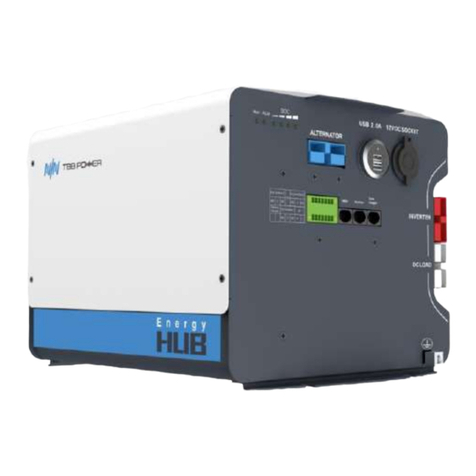
TBB power
TBB power Energy Hub EH128L user manual
